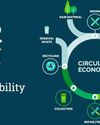SISAL FIBRE SPINNING
Textile Value Chain
|July 2020
Highlight of the article:Sisal fiber obtained from the plant Agave Sisalana, yields a stifffibre, traditionally used in making twine, rope and also dartboards. Today Brazil is major world producer of sisal.The first commercial plantings in Brazil were made in late 1930’s and the first sisal fibre exports from there were made in 1946. Sisal plants consists of a rosette of sword-shaped leaves about 1.5 to 2 meters long.Young leaves may have a few minute thin along their margins, but lose them as they mature. The sisal plant has a 7-10 years life time and typically produces 200-250 commercially usable leaves. Traditionally, sisal has been the leading material for agricultural twin (binder twin and baler twin) because of its strength, durability to stretches, affinity for certain dyestuffs, and resistance to deteriorstion in salt water.But the importance of this traditional use is diminishing with competition from polypropylene and the development of other haymaking techniques, while new higher-valued sisal has been developed.

Natural fibres are fibres that are produced by plants, animals, and geological processes. One of the most widely used natural fibers is Sisal fiber. It is also very easily cultivated. You can obtain Sisal fiber from Sisal plant. The plant, was formally known as Agave Sisalana. These plants produce rosettes of sword-shaped leaves which start out toothed, and gradually lose their teeth with maturity. Decortication is a process in which every leaf loses its long, straight fibers. During decortication, the leaves are beaten down to remove the pulp and plant material, leaving the tough fibers behind.

Sisal fiber is a high renewable source of energy , also it is fully biodegradable. Green composites were fabricated with soy protein resin which were modified with gelatin. Sisal fiber, modified soy protein resins, and composites were characterized for their mechanical and thermal properties. Sisal fibre is low maintenance with minimal wear and tear, and exceptionally durable. It is not suitable for a smooth wall finish and also not recommended for wet areas, because it is too tough for textiles and fabrics.
Cette histoire est tirée de l'édition July 2020 de Textile Value Chain.
Abonnez-vous à Magzter GOLD pour accéder à des milliers d'histoires premium sélectionnées et à plus de 9 000 magazines et journaux.
Déjà abonné ? Se connecter
PLUS D'HISTOIRES DE Textile Value Chain

Textile Value Chain
EPR in Textiles: Turning Compliance into Opportunity
When the EU Comes to Panipat, It Means One Thing — The World Is Watching
3 mins
November 2025

Textile Value Chain
European Parliament Delegation Visits Panipat Recycling Cluster to Strengthen India-EU Collaboration on Circular Textiles
A high-level delegation from the European Parliament's Committee on International Trade (INTA) visited the Panipat Textile Recycling Cluster — India's largest hub for recycled textiles and circular manufacturing — during their official visit to India.
1 mins
November 2025

Textile Value Chain
Paramount Instruments: Where Innovation Turns Testing into Joy
At Paramount Instruments, innovation isn't just a Pursuit- it's in our DNA.
2 mins
November 2025
Textile Value Chain
Crafting the Future: LMW & Hami Weavelon pioneer Compact Spinning in Polyester
Manmade fibres today form the backbone of the global textile industry, driven by their versatility, performance, and ability to meet the rising demand for both everyday and specialised applications.
3 mins
November 2025

Textile Value Chain
Data is the New Thread: Weaving India's Textile Sector into a Circular Powerhouse
On November 13, 2025, at the 12th Edition of the India and Sustainability Standards (ISS) International Dialogue and Conference held at Bharat Mandapam in New Delhi, representatives from the Home Exporters Welfare Association of India (HEWA) joined industry leaders, policymakers, and international organizations to address a pressing question: How can India's textile sector meet emerging global data requirements while supporting its MSME backbone?
3 mins
November 2025

Textile Value Chain
Rieter Winding Suction Nozzle Upgrade: More Yarn, Less Energy Use
After upgrading the suction nozzles on their 32 winding machines, Sanyang Textile Co., Ltd., China, saw an increase in yarn production of 3% and a reduction of 13% in energy use. The flow-optimised, aerodynamically designed suction nozzle enables efficient upper yarn search and pickup from the package. This results in a 55% reduction in red light percentage and a significant reduction in the operator's workload.
1 mins
November 2025

Textile Value Chain
EU's Extended Producer Responsibility (EPR) Law and Its Implications for India's Textile Industry
The European Union (EU) has approved a new Extended Producer Responsibility (EPR) framework for textiles. This is a major regulatory shift that makes fashion brands and producers accountable for their products' entire lifecycle, from design and production through collection, sorting, recycling and disposal.
9 mins
November 2025

Textile Value Chain
GTE Ahmedabad 2025 Concludes Day 3 with a Huge Footfall
The 38th Garment Technology Expo (GTE) Ahmedabad 2025, co-located with the Lace & Trims Show, wrapped up its third day on an impressive note, recording around 9,700 B2B visitors. The strong industry turnout reaffirmed the expo's role as one of the most influential and business-driven platforms for garment and apparel technology in the western region.
2 mins
November 2025

Textile Value Chain
Reinterpreting Korean Street Fashion through Sustainable Design Practices
A Path through Eco-conscious Urban Fashion
7 mins
November 2025

Textile Value Chain
3D Printing in Textiles Manufacturing: A Game-Changer in Design, Sustainability, and Efficiency
The global textile and apparel industry is undergoing a radical transformation due to the convergence of digital design, advanced material technology, and next-generation manufacturing. Of the latter, few have greater potential to change how textiles are made today than additive manufacturing, better known as 3D printing.
5 mins
November 2025
Translate
Change font size

